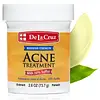What's inside
What's inside
 Key Ingredients
Key Ingredients

No key ingredients
 Benefits
Benefits

 Concerns
Concerns

 Ingredients Side-by-side
Ingredients Side-by-side

Sulfacetamide Sodium 10%
Sulfur 5%
AntiseborrhoeicBHT
AntioxidantCetyl Alcohol
EmollientDisodium EDTA
Disodium Oleamido Mea-Sulfosuccinate
CleansingGlyceryl Stearate
EmollientMagnesium Aluminum Silicate
AbsorbentMethylparaben
PreservativePEG-100 Stearate
Petrolatum
EmollientPropylene Glycol
HumectantPropylparaben
PreservativeWater
Skin ConditioningSodium Cocoyl Isethionate
CleansingSodium Methyl Cocoyl Taurate
CleansingSodium Thiosulfate
Stearyl Alcohol
EmollientXanthan Gum
EmulsifyingSulfacetamide Sodium 10%, Sulfur 5%, BHT, Cetyl Alcohol, Disodium EDTA, Disodium Oleamido Mea-Sulfosuccinate, Glyceryl Stearate, Magnesium Aluminum Silicate, Methylparaben, PEG-100 Stearate, Petrolatum, Propylene Glycol, Propylparaben, Water, Sodium Cocoyl Isethionate, Sodium Methyl Cocoyl Taurate, Sodium Thiosulfate, Stearyl Alcohol, Xanthan Gum
 Reviews
Reviews

Alternatives
Ingredients Explained
These ingredients are found in both products.
Ingredients higher up in an ingredient list are typically present in a larger amount.
Sulfur is a commonly occurring element on Earth (and our universe!). In cosmetics, it helps kill bacteria, reduces sebum, and provides exfoliation. This makes it an effective ingredient to reduce breakouts and fight acne.
As a ketayolytic agent, it breaks down the top layer of skin. This is a form of exfoliation and may help decrease acne and hyperpigmentation.
Studies show sulfur has antibacterial and antifungal properties. Sulfur can be drying if used excessively or at higher concentrations. We recommend speaking with a medical professional if you have any concerns.
Ancient Greece, India, China, and Egypt have used sulfur in both traditional medicines and for household use.
Learn more about Sulfur